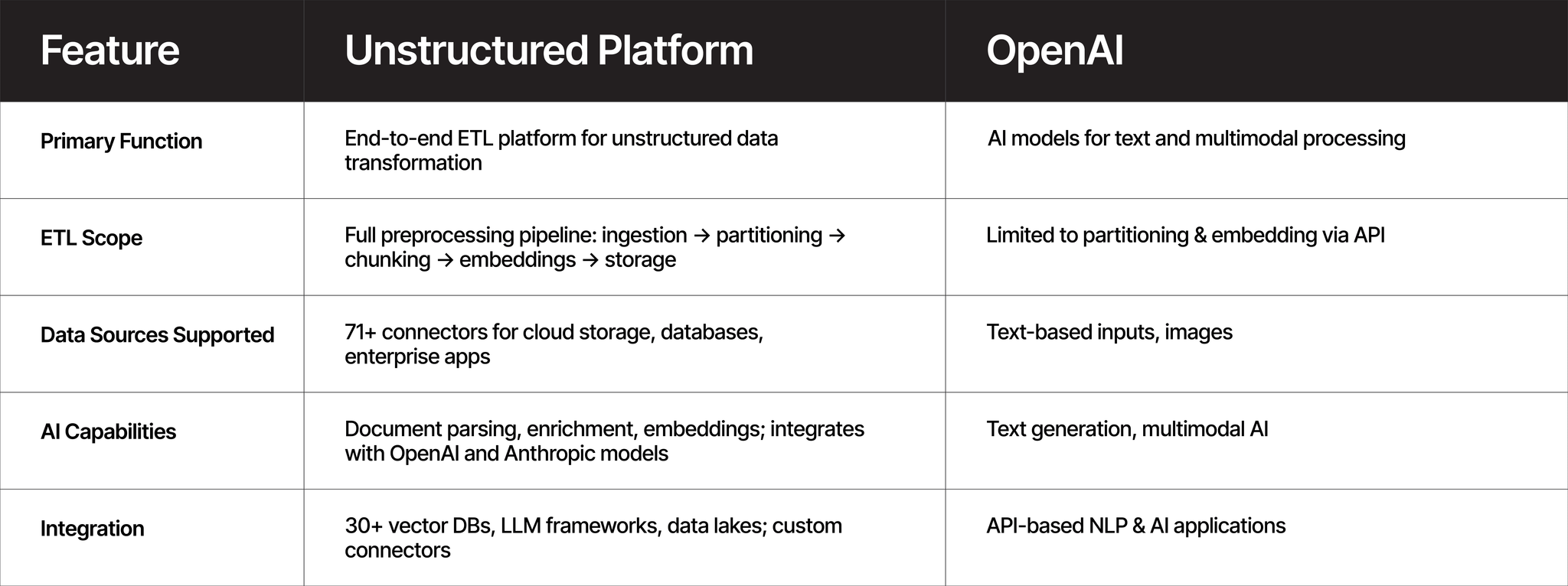
Authors

What is Unstructured?
The Unstructured Platform is a specialized solution designed to transform unstructured data—such as PDFs, emails, and scanned documents—into structured, machine-readable formats. It supports various document processing workflows, making it an ideal choice for AI applications, Retrieval-Augmented Generation (RAG) systems, and enterprise data pipelines. Recent advancements in orchestration capabilities and enterprise-grade scalability have positioned Unstructured as the backbone of production AI systems, enabling organizations to operationalize unstructured data at an unprecedented scale.
Try out the Unstructured Platform today. Learn more here.
Key Features of Unstructured
- No-Code Data Processing: Enables users to convert raw unstructured data into a structured format without writing custom code.
- Diverse Data Source Support: Connects to cloud storage services (AWS S3, Azure Blob, GCP), databases (Databricks, Elasticsearch, OpenSearch), and enterprise platforms (Salesforce, Google Drive, SharePoint).
- Advanced Partitioning & Chunking: Employs multiple partitioning strategies (Fast, HiRes, Auto) and intelligent chunking methods (By Title, By Page, By Similarity) to optimize content extraction.
- AI-Powered Enrichment: Generates metadata, captions, and embeddings for AI-driven document retrieval and analysis.
- Vector Database Integration: Seamlessly integrates with Pinecone, Weaviate, Chroma, Elasticsearch, OpenSearch, and other storage destinations.
- Scalability for Enterprise AI: Designed to handle high-volume ETL workloads.
Workflow Orchestration Engine
The platform’s orchestration layer manages complex scheduling, automatic retries, and parallel processing of over 53,000 documents per job while maintaining millisecond latency between processing steps. Unlike limited AI models that focus solely on partitioning and embedding, Unstructured provides end-to-end orchestration capabilities, including:
- Real-time document detection with automated triggering of processing pipelines.
- Intelligent incremental updates that reprocess only modified content.
- Horizontal scaling across multiple data planes in hybrid cloud environments.
- Embedded metadata governance tracking data lineage from source to vector store.
Enterprise Scalability
Performance benchmarks indicate that the hosted SaaS deployment processes over 15 million pages per hour per workflow, with proven scalability to petabytes of unstructured data. For organizations requiring full control, the in-VPC deployment model eliminates data egress costs while providing unlimited scaling based on private infrastructure capacity. This architecture supports multi-region processing with centralized governance, essential for global enterprises managing localized data residency requirements.
Enterprise Integrations
With over 71 pre-built connectors spanning storage systems, LLM providers, and vector databases, Unstructured Platform acts as the central nervous system for GenAI data pipelines. Current production integrations include direct access to OpenAI and Anthropic models for embeddings and enrichment, with expanded model support scheduled for Q2 2025. The platform’s API-first design allows custom integration with any third-party service while maintaining SOC 2 Type 2 compliance across all data flows.
Read more about how Unstructured can help you do Production-Ready data processing for GenAI here.
What is OpenAI?
OpenAI is an AI research and deployment company renowned for developing advanced language models like GPT-4 and multimodal AI models such as DALL·E and Whisper. These models are widely used for tasks including text generation, summarization, translation, and AI-driven decision-making.
Key Features of OpenAI
- Natural Language Processing (NLP): Generates human-like text for chatbots, content creation, and summarization.
- Multimodal Capabilities: Processes both text and images (e.g., DALL·E for image generation, Whisper for speech recognition).
- Fine-Tuned AI Models: Offers model fine-tuning for domain-specific applications.
- Integration with APIs: Provides developers with API access to GPT models for embedding AI capabilities into applications.
- Advanced AI Reasoning: Optimized for complex problem-solving and knowledge retrieval.
Unstructured vs. OpenAI: A Feature Comparison

Choosing the Right Data Processing Tool for Your Use Case
While OpenAI provides powerful AI-driven text and multimodal processing capabilities, it operates as a component within AI pipelines rather than a complete data processing solution. The Unstructured Platform differentiates itself through production-ready orchestration that manages the entire document lifecycle—from initial ingestion in SaaS apps to optimized storage in vector databases. For organizations deploying GenAI at scale, Unstructured offers critical infrastructure that AI models like those from OpenAI rely upon for accessing enterprise knowledge.
Key differentiators include:
- Comprehensive ETL vs. Limited Processing: While AI models focus on specific transformation steps, Unstructured manages the entire pipeline, including credential rotation, error handling, and compliance auditing.
- Enterprise-Grade Security: With in-VPC processing and zero-data retention policies, Unstructured meets strict regulatory requirements that general AI models may not address.
- Model Agnosticism: Direct integration with leading LLMs (OpenAI, Anthropic) today, with a flexible architecture to incorporate new models as they emerge.
At Unstructured, we're committed to simplifying the process of preparing unstructured data for AI applications. Our platform empowers you to transform raw, complex data into structured, machine-readable formats, enabling seamless integration with your AI ecosystem. To experience the benefits of Unstructured firsthand, get started today and let us help you unleash the full potential of your unstructured data.


